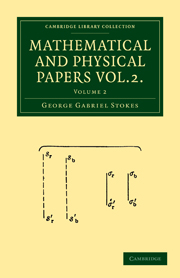Book contents
- Frontmatter
- Contents
- Notes on Hydrodynamics. III. On the Dynamical Equations
- On the constitution of the Luminiferous Ether
- On the Theory of certain Bands seen in the Spectrum
- Notes on Hydrodynamics. IV. Demonstration of a Fundamental Theorem
- On a difficulty in the Theory of Sound
- On the Formation of the Central Spot of Newton's Rings beyond the Critical Angle
- On some points in the Received Theory of Sound
- On the perfect Blackness of the Central Spot in Newton's Rings, and on the Verification of Fresnel's Formula for the intensities of Reflected and Reflacted Rays
- On Attractions, and on Clairaut's Theorem
- On the Variation of Gravity at the Surface of the Earth
- On a Mode of Measuring the Astigmatism of a Defective Eye
- On the Determination of the Wave Length corresponding with any Point of the Spectrum
- Discussion of a Differential Equation relating to the Breaking of Railway Bridges
- Notes on Hydrodynamics, VI. On Waves
- On the Dynamical Theory of Diffraction
- On the Numerical Calculation of a class of Definite Integrals and Infinite Series
- On the Mode of Disappearance of Newton's Rings in passing the Angle of Total Internal Reflection
- On Metallic Reflection
- On a Fictitious Displacement of Fringes of Interference
- On Haidinger's Brushes
- Index
Discussion of a Differential Equation relating to the Breaking of Railway Bridges
Published online by Cambridge University Press: 07 September 2010
- Frontmatter
- Contents
- Notes on Hydrodynamics. III. On the Dynamical Equations
- On the constitution of the Luminiferous Ether
- On the Theory of certain Bands seen in the Spectrum
- Notes on Hydrodynamics. IV. Demonstration of a Fundamental Theorem
- On a difficulty in the Theory of Sound
- On the Formation of the Central Spot of Newton's Rings beyond the Critical Angle
- On some points in the Received Theory of Sound
- On the perfect Blackness of the Central Spot in Newton's Rings, and on the Verification of Fresnel's Formula for the intensities of Reflected and Reflacted Rays
- On Attractions, and on Clairaut's Theorem
- On the Variation of Gravity at the Surface of the Earth
- On a Mode of Measuring the Astigmatism of a Defective Eye
- On the Determination of the Wave Length corresponding with any Point of the Spectrum
- Discussion of a Differential Equation relating to the Breaking of Railway Bridges
- Notes on Hydrodynamics, VI. On Waves
- On the Dynamical Theory of Diffraction
- On the Numerical Calculation of a class of Definite Integrals and Infinite Series
- On the Mode of Disappearance of Newton's Rings in passing the Angle of Total Internal Reflection
- On Metallic Reflection
- On a Fictitious Displacement of Fringes of Interference
- On Haidinger's Brushes
- Index
Summary
To explain the object of the following paper, it will be best to relate the circumstance which gave rise to it. Some time ago Professor Willis requested my consideration of a certain differential equation in which he was interested, at the same time explaining its object, and the mode of obtaining it. The equation will be found in the first article of this paper, which contains the substance of what he communicated to me. It relates to some experiments which have been performed by a Royal Commission, of which Professor Willis is a member, appointed on the 27th of August, 1847, “ for the purpose of inquiring into the conditions to be observed by engineers in the application of iron in structures exposed to violent concussions and vibration. ” The object of the experiments was to examine the effect of the velocity of a train in increasing or decreasing the tendency of a girder bridge over which the train is passing to break under its weight. In order to increase the observed effect, the bridge was purposely made as slight as possible: it consisted in fact merely of a pair of cast or wrought iron bars, nine feet long, over which a carriage, variously loaded in different sets of experiments, was made to pass with different velocities.
- Type
- Chapter
- Information
- Mathematical and Physical Papers , pp. 178 - 220Publisher: Cambridge University PressPrint publication year: 2009First published in: 1883
- 13
- Cited by



